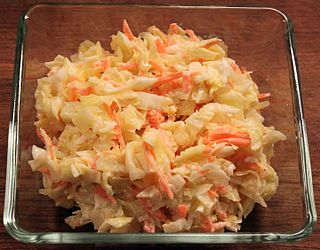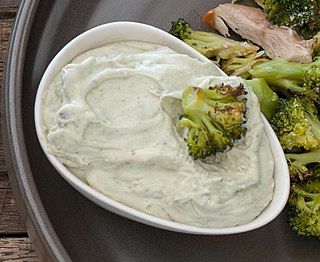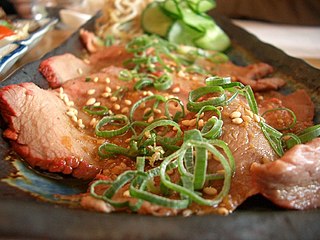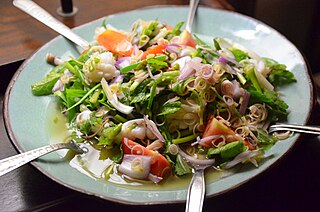
A Caesar salad is a green salad of romaine lettuce and croutons dressed with lemon juice, olive oil, egg, Worcestershire sauce, anchovies, garlic, Dijon mustard, Parmesan cheese, and black pepper.

A salad is a dish consisting of mixed, mostly natural ingredients with at least one raw ingredient. They are typically served at room temperature or chilled, though some can be served warm. Condiments and salad dressings, which exist in a variety of flavors, are often used to enhance a salad.

A salad dressing is a sauce for salads. Used on virtually all leafy salads, dressings may also be used in making salads of beans, noodle or pasta salads and antipasti, and forms of potato salad.

Potato salad is a salad dish made from boiled potatoes, usually containing a dressing and a variety of other ingredients such as boiled eggs and raw vegetables.
Albanian cuisine is a representative of the cuisine of the Mediterranean. It is also an example of the Mediterranean diet based on the importance of olive oil, fruits, vegetables and fish. The cooking traditions of the Albanian people are diverse in consequence of the environmental factors that are more importantly suitable for the cultivation of nearly every kind of herbs, vegetables and fruits. Olive oil is the most ancient and commonly used vegetable fat in Albanian cooking, produced since antiquity throughout the country particularly along the coasts.

Green sauce or greensauce is a family of cold, uncooked sauces based on chopped herbs, including the Spanish and Italian salsa verde, the French sauce verte, the German Grüne Soße or Frankfurter Grie Soß, the British mint sauce and greensauce, and the Argentinian chimichurri.

Coleslaw, also known as cole slaw, or simply as slaw, is a side dish consisting primarily of finely shredded raw cabbage with a salad dressing or condiment, commonly either vinaigrette or mayonnaise. This dish originated in the Netherlands in the 18th century. Coleslaw prepared with vinaigrette may benefit from the long lifespan granted by pickling.

French dressing, in consumer-facing American cuisine and store-bought products in the United States, is a creamy dressing that varies in color from pale orange to bright red. It is made of oil, vinegar, sugar, and other flavorings, with the coloring derived from tomato and often paprika. It exists on a spectrum between Russian and Catalina dressing.

Blue cheese dressing is a popular side sauce, salad dressing and dip in the United States. It is usually made of some combination of blue cheese, mayonnaise, and buttermilk, sour cream or yogurt, milk, vinegar, onion powder, and garlic powder. There is a blue cheese vinaigrette that consists of salad oil, blue cheese, vinegar, and sometimes seasonings.

Salade niçoise, salada nissarda in the Niçard dialect of the Occitan language, insalata nizzarda in Italian, is a salad that originated in the French city of Nice. It is traditionally made of tomatoes, hard-boiled eggs, Niçoise olives and anchovies or tuna, dressed with olive oil, or in some historical versions, a vinaigrette. It has been popular worldwide since the early 20th century, and has been prepared and discussed by many chefs. Delia Smith called it "one of the best combinations of salad ingredients ever invented" and Gordon Ramsay said that "it must be the finest summer salad of all".

Bean salad is a common cold salad composed of various cooked beans – typically green, wax, kidney, and/or lima beans - tossed in a sweet-sour vinaigrette. Variant ingredients include fresh raw onions, bell pepper, and/or other cooked or raw vegetables, such as chickpeas.

Wish-Bone is an American brand of salad dressing, marinades, dips and pasta salad. The original salad dressing was based on a recipe served at the Wishbone restaurant in Kansas City, Missouri, founded by ex-soldier Phillip Sollomi in 1945 along with Lena Sollomi, Phillip's mother. The Italian dressing served at the Wishbone was based on a recipe from Lena Sollomi's Sicilian family which was a blend of oil, vinegar, herbs and spices. Demand for the salad dressing proved so high that Phillip started a separate operation to produce it for sale, making it by the barrel. The brand was acquired by Lipton, part of the Unilever portfolio, in 1958, and was manufactured in the Kansas City area. In 2013, Pinnacle Foods acquired Wish-Bone from Unilever. In turn, ConAgra acquired Pinnacle Foods on October 26, 2018.
Oil and vinegar may refer to:

Pasta salad is a salad dish prepared with one or more types of pasta, almost always chilled, and most often tossed in a vinegar, oil, or mayonnaise-based dressing. It is typically served as an appetizer, side dish or a main course. Pasta salad is often regarded as a spring or summertime meal, but it can be served any time of year.

Chinese chicken salad is a salad including chopped chicken and Chinese culinary ingredients that is common in parts of the United States. Though many variations exist, common features of Chinese chicken salads include lettuce, cabbage, chicken, deep-fried wonton skins or rice vermicelli and nuts. A basic vinaigrette for the salad includes ingredients like vegetable oil, sesame oil, rice vinegar. Optional seasonings include dry hot mustard, sesame seeds, coriander and raw ginger or pickled ginger. In restaurants, Chinese chicken salad may be more embellished and offered as an American-style entree salad, similar to Caesar, Chef, and Cobb salads.

Wafu dressing, literally “Japanese-style dressing”, is a vinaigrette-type salad dressing based on tosazu, popular in Japan.

Vinaigrette is made by mixing an oil with a mild acid such as vinegar or lemon juice. The mixture can be enhanced with salt, herbs and/or spices. It is used most commonly as a salad dressing, but can also be used as a marinade. Traditionally, a vinaigrette consists of 3 parts oil and 1 part vinegar mixed into a stable emulsion, but the term is also applied to mixtures with different proportions and to unstable emulsions which last only a short time before separating into layered oil and vinegar phases.

Salads that are internationally known as Thai salads with a few exceptions fall into four main preparation methods. In Thai cuisine these are called yam, tam, lap and phla. A few other dishes can also be regarded as being a salad.


















